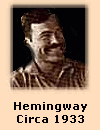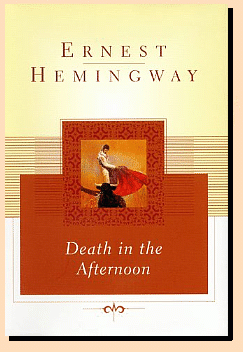
Hemingway on Bulls, Etc.
Perhaps it is unfair for me to write of Ernest Hemingway, for he is, far and away and without fear of competition, my favorite author. I am thus heavily biased in his favor, and I am quite sure that, given opportunity such as this, I will forever praise him to High Heaven, whether he writes of bullfights, war, love, hate, belles lettres, venereal diseases or the art of crocheting.
 I have just read Death in the Afternoon (Scribner's), the latest work by my white-haired boy, and I am prepared to bring out my old hackneyed phrases and call it a great book. But first, please, forgive me my little bias, if only in consideration of the tremendous and widespread acclaim accorded it by others since its publication several months ago.
I have just read Death in the Afternoon (Scribner's), the latest work by my white-haired boy, and I am prepared to bring out my old hackneyed phrases and call it a great book. But first, please, forgive me my little bias, if only in consideration of the tremendous and widespread acclaim accorded it by others since its publication several months ago.
Death in the Afternoon is not a defense of a bloody, murderous spectacle. Nor is it an indictment. It is a recitation of Ernest Hemingway's emotional reactions to the bullfight, and is intermingled with a thorough explanation of that sport, and with essential historical facts. If it were merely a book about bullfighting, it would nevertheless be swift, engaging reading, replete with the vigor and straightforwardness of Heminway, his opinions of life and letters, his humor, and his indisputable supremacy where a conveyance of innermost feelings is put down on paper.
 But, this is more than a book ahout bullfighting. Readers will find a great deal more. For instance, a fast-moving, high-tension short story about war, which, highly reminiscent of A Farewell to Arms, serves to illustrate the impropriety of life; a short estimate of William Faulkner wherein he is praised for his rare ability to write certain books about certain touchy subjects and, yet, stay out of certain jails.
But, this is more than a book ahout bullfighting. Readers will find a great deal more. For instance, a fast-moving, high-tension short story about war, which, highly reminiscent of A Farewell to Arms, serves to illustrate the impropriety of life; a short estimate of William Faulkner wherein he is praised for his rare ability to write certain books about certain touchy subjects and, yet, stay out of certain jails.
In addition, Death in the Afternoon may well be referred to as a book about Spain and its inhabitants. The author knows the country and the people, and what he says is authentic. He writes a great deal about literature, too, and about life. His language is strong and forthright, and especially so when he takes time to assail Meier-Graefe because that impressario lauded El Greco but damned two really great Italian artists--Velasquez and Goya--because of their alleged inability to paint the Crucifixion.
Aware of the fact that a technical explanation of any given subject ultimately must bore the reader, Hemingway introduces into the book an old lady, a mythical being, who often reminds him that his story is lagging in interest. She tires of bullfighting chatter, says so, and thus the author must voice his opinions and his knowledge of other things. The value of the old lady--I became deeply fond of her--is incalculable. She is, in part, responsible for the success of this book, and the author's talks with her, decidedly informal and outright, will delight you.
The author is well-informed. He has witnessed bullfights throughout Spain over a period of years. He has studied its history, and he possesses a profound understanding of matadors and their enemies--the fighting bulls. When you have read this book you will toss off your preconceived impressions and agree with Ernest Hemingway that bullfighting is an art, and that death, in the afternoon, if ofttimes truly aesthetic, if a bit gory.
The book is illustrated with some 75 full-page photographs. Intensely graphic, they will surely help the reader to understand the bullfight. There is, too, a chapter on the "Reactions of a Few Individuals to the Integral Spanish Bullfight" and a short estimate, brimming with merited praise, of Sidney Franklin, the American bullfighter.
____
|

